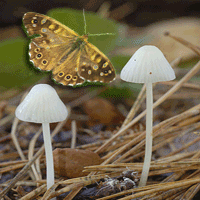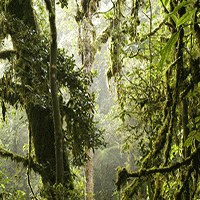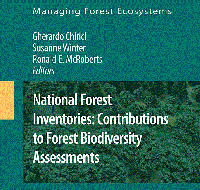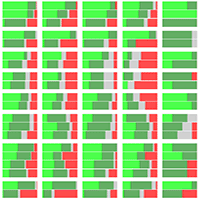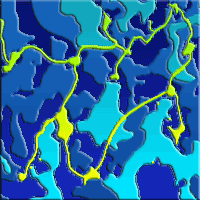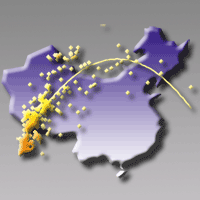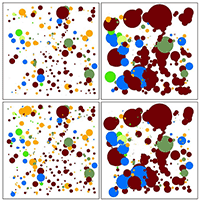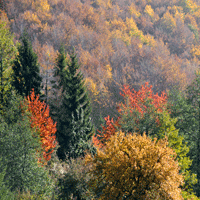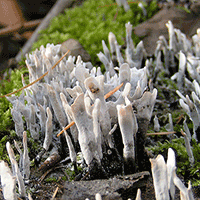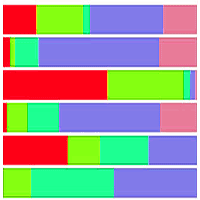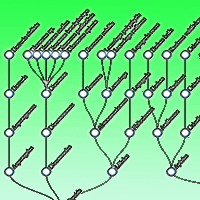
Taxonomic distinctness of climbing plants and epiphytes in central-Chilean forests: an alternative diversity measure from unequal species lists
iForest - Biogeosciences and Forestry, Volume 18, Issue 5, Pages 283-292 (2025)
doi: https://doi.org/10.3832/ifor4693-018
Published: Oct 20, 2025 - Copyright © 2025 SISEF
Research Articles
Abstract
Protected wild areas aim to conserve biodiversity. However, a lack of monitoring limits the availability of biological information needed to achieve this goal. This study used taxonomic distinctness (Δ+), its variance (Λ+), and a combined metric of both measures as alternative methods to monitor the diversity of climbing plants and vascular epiphytes in the absence of standardized data over time and space. The study was conducted in five forested small protected areas within the biodiversity hotspot of central Chile. The method involved updating the species inventory and comparing it with those from previous studies. The results showed that epiphytes followed a general pattern of increasing diversity towards the south along the latitudinal gradient (Δ+ between 54.95 and 73.3), while climbers remained more stable (Δ+ between 70.33 and 72.33). The combined analysis of both indices (Δ+ and Λ+) suggested that both climbers and epiphytes gained taxonomic diversity over time at most sites (p < 0.05). Sites that did not follow this general pattern may reflect differences in sampling design between the original and current inventories, which may have influenced the results. This observation requires further investigation as anthropogenic pressures may explain these variations. Future research should focus on long-term monitoring of the taxonomic distinctness of both assemblages to assess their responses to environmental disturbance and climate change, thereby providing a basis for developing more effective conservation strategies.
Keywords
Biodiversity Hotspot, Ecotone, Species Composition, Vascular Plants
Authors’ Info
Authors’ address
Núcleo de Estudios Ambientales y Laboratorio de Planificación Territorial, Departamento de Ciencias Ambientales, Universidad Católica de Temuco, Rudecindo Ortega 02950, Temuco (Chile)
Corresponding author
Paper Info
Citation
Pincheira-Ulbrich J (2025). Taxonomic distinctness of climbing plants and epiphytes in central-Chilean forests: an alternative diversity measure from unequal species lists. iForest 18: 283-292. - doi: 10.3832/ifor4693-018
Academic Editor
Francisco Lloret Maya
Paper history
Received: Jul 23, 2024
Accepted: Jul 21, 2025
First online: Oct 20, 2025
Publication Date: Oct 31, 2025
Publication Time: 3.03 months
Copyright Information
© SISEF - The Italian Society of Silviculture and Forest Ecology 2025
Open Access
This article is distributed under the terms of the Creative Commons Attribution-Non Commercial 4.0 International (https://creativecommons.org/licenses/by-nc/4.0/), which permits unrestricted use, distribution, and reproduction in any medium, provided you give appropriate credit to the original author(s) and the source, provide a link to the Creative Commons license, and indicate if changes were made.
Web Metrics
Breakdown by View Type
Article Usage
Total Article Views: 1111
(from publication date up to now)
Breakdown by View Type
HTML Page Views: 311
Abstract Page Views: 464
PDF Downloads: 305
Citation/Reference Downloads: 1
XML Downloads: 30
Web Metrics
Days since publication: 53
Overall contacts: 1111
Avg. contacts per week: 146.74
Citation Metrics
Article Citations
Article citations are based on data periodically collected from the Clarivate Web of Science web site
(last update: Mar 2025)
(No citations were found up to date. Please come back later)
Publication Metrics
by Dimensions ©
Articles citing this article
List of the papers citing this article based on CrossRef Cited-by.
References
Flora de cuatro Reservas Nacionales en la Cordillera de la Costa de la VII Región (35°-36° S), Chile, y su papel en la protección de la biodiversidad regional [Flora of four National Reserves in the Coastal Range of Region VII (35°-36° S), Chile, and their role in protecting regional biodiversity]. In: “Historia, Biodiversidad y Ecología de los Bosques Costeros de Chile” (Smith-Ramírez C, Armesto JJ, Valdovinos C, eds). Editorial Universitaria, Santiago, Chile, pp. 225-244. [in Spanish]
Gscholar
Catálogo de la flora vascular del Monumento Natural Contulmo, Chile [Catalogue of the vascular flora of the Contulmo Natural Monument, Chile]. Gayana Botánica 56 (2): 125-135. [in Spanish]
Gscholar
Field and laboratory methods for general ecology (3rd edn). Wm. C. Brown Publishers, Dubuque, IA, USA, pp. 273.
Gscholar
Non-parametric estimation of the number of classes in a population. Scandinavian Journal of Statistics 11: 265-270.
Gscholar
PRIMER v7: User Manual/Tutorial. PRIMER-E, Plymouth, UK, pp. 296.
Gscholar
Evaluación florística y sinecología del Monumento Natural Cerro Ñielol (IX Región, Chile) [Floristic and synecological evaluation of the Cerro Ñielol Natural Monument (IX Region, Chile)]. Boletín Museo Regional de la Araucanía 3: 7-32. [in Spanish]
Gscholar
Sinopsis bioclimática y vegetacional de Chile [Bioclimatic and vegetation synopsis of Chile]. Editorial Universitaria, Santiago, Chile, pp. 316. [in Spanish]
Gscholar
Plantas trepadoras, epífitas y parásitas nativas de Chile: guía de campo [Climbing, epiphytic, and parasitic plants native to Chile: field guide]. Ediciones Corporación Chilena de la Madera, Concepción, Chile, pp. 196. [in Spanish]
Gscholar
Longevity can buffer plant and animal populations against changing climatic variability. Ecology 89 (1): 19-25.
CrossRef | Gscholar
CoordinateCleaner: standardized cleaning of occurrence records from biological collection databases. Methods in Ecology and Evolution 10 (5): 744-751.
CrossRef | Gscholar

